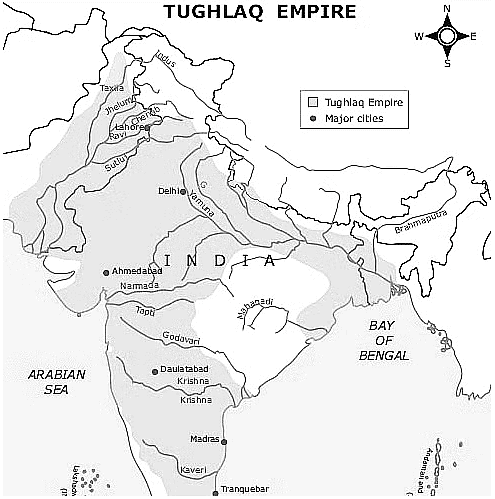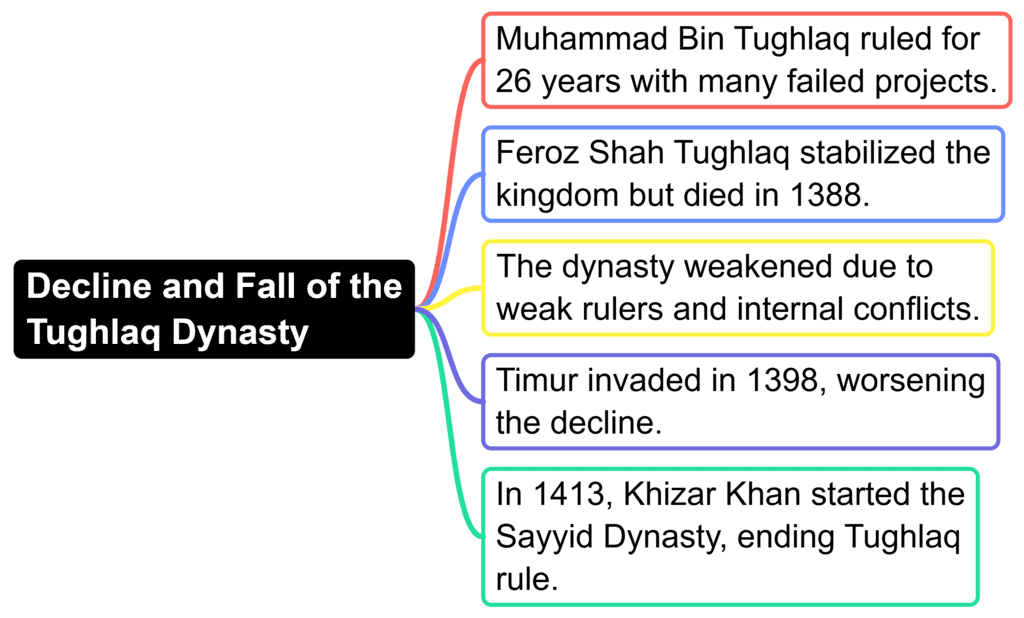UPSC Exam > UPSC Notes > History for UPSC CSE > The Tughlaq Dynasty: The Delhi Sultanate
The Tughlaq Dynasty: The Delhi Sultanate | History for UPSC CSE PDF Download
| Table of contents |

|
| Origin of the Tughlaq Dynasty |

|
| Key Rulers of the Tughlaq Dynasty |

|
| Later Tughlaqs |

|
| Decline and Fall of the Tughlaq Dynasty |

|
Origin of the Tughlaq Dynasty
The Tughlaq Dynasty was of Turkish origin, with Islam as the family religion. Ghazi Tughlaq ascended the throne in 1321, taking the title Ghiyasuddin Tughlaq. The dynasty's longevity can be attributed to strong alliances with Turks, Afghans, and South Asian Muslim warriors. Despite the internal strife, marked by torture and rebellions, which led to its rapid territorial disintegration post-1335 AD, the dynasty reached its zenith between 1330 and 1335 AD under Muhammad Bin Tughlaq.
Key Rulers of the Tughlaq Dynasty
Ghiyas-ud-din Tughlaq (Ghazi Malik) (1320-1325 AD)- Ghiyas-ud-din Tughlaq, the dynasty's founder, was born to a Turk father and a Punjabi Jat mother.
- He fortified the north-western frontier against Mongol invasions and established the city of Tughlaqabad.
- His son, Fakhr-ud-din Muhammad Jauna Khan, defeated the Kakatiya ruler Prataparudra-Deva II of Warangal.
- Ghiyas-ud-din Tughlaq died in 1325 under mysterious circumstances, possibly orchestrated by his son.
Muhammad-bin-Tughlaq (1325-1361 AD)
- Succeeding his father in 1325, Muhammad-bin-Tughlaq was a renowned scholar, fluent in Arabic and Persian, and knowledgeable in various sciences.
- He maintained amicable relations with foreign powers, including the Chinese ruler.
- He sent the Moroccan traveler Ibn Batutah as an envoy to China.
- Despite his intellectual prowess, many of Muhammad-bin-Tughlaq's ambitious projects failed due to poor execution and lack of support.
Firoz Tughlaq (1351-1388 AD)
- Firoz Tughlaq, succeeding his cousin Muhammad-bin-Tughlaq, ruled from 1351 to 1388 AD.
- Known for paying his army in land rather than cash, he was dubbed the "Father of the Irrigation Department" by the British due to his extensive canal-building projects.
- He implemented taxes such as Kharaj, Zakat, Kham, and Jaziya.
- His reign was marked by relative stability and infrastructural development.
Later Tughlaqs
Ghiyas-ud-din Tughlaq Shah II- Ghiyas-ud-din Tughlaq Shah II succeeded Firoz Tughlaq in 1388 but was beheaded within a year due to court intrigues.
- The next five years saw rapid succession with three sultans: Abu Bakr, Muhammad Shah, and Humayun (Alauddin Sikander Shah).
Abu Bakr Shah (1389-90 AD)
- Abu Bakr Shah, ruling briefly from 1389 to 1390, faced opposition from his uncle Muhammad Shah, who eventually defeated him and took the throne.
- Abu Bakr was imprisoned and died shortly after his defeat.
Nasir-ud-din Muhammad Tughlaq (1390-94 AD)
- Nasir-ud-din Muhammad Tughlaq ruled from 1390 to 1394, focusing on suppressing revolts and internal dissent.
- He crushed Hindu uprisings in Etawah and established the Sharqi dynasty in Jaunpur through his general Malik Sarvar.
- His reign ended amid continued internal strife.
Decline and Fall of the Tughlaq Dynasty

Conclusion
- By the end of the Tughlaq dynasty in 1412, the Sultanate was reduced to a small territory in north India.
- Numerous regions gained independence, including East Bengal, Orissa, and the Sharqi kingdom in eastern Uttar Pradesh and Bihar.
- The Vijaynagar empire and the Bahmani kingdom rose in the Deccan and South India, while Gujarat, Malwa, and parts of Punjab also declared autonomy.
- Rajasthan's Rajput states ceased to recognize the authority of the Delhi Sultans.
The document The Tughlaq Dynasty: The Delhi Sultanate | History for UPSC CSE is a part of the UPSC Course History for UPSC CSE.
All you need of UPSC at this link: UPSC
|
216 videos|855 docs|219 tests
|
FAQs on The Tughlaq Dynasty: The Delhi Sultanate - History for UPSC CSE
| 1. Who founded the Tughlaq Dynasty in the Delhi Sultanate? |  |
Ans. The Tughlaq Dynasty was founded by Ghiyasuddin Tughlaq.
| 2. What were some of the major achievements of the Tughlaq Dynasty during their rule in the Delhi Sultanate? |  |
Ans. Some major achievements of the Tughlaq Dynasty include the construction of the Tughlaqabad Fort and the establishment of the city of Tughlaqabad.
| 3. How did the Tughlaq Dynasty contribute to the spread of Islam in the Indian subcontinent? |  |
Ans. The Tughlaq Dynasty actively promoted Islam through the construction of mosques, madrasas, and other religious institutions, as well as through the patronage of Sufi saints.
| 4. What led to the decline of the Tughlaq Dynasty in the Delhi Sultanate? |  |
Ans. The Tughlaq Dynasty faced challenges such as revolts, administrative inefficiency, and economic problems, which ultimately led to their decline.
| 5. How did the Tughlaq Dynasty impact the cultural and architectural landscape of the Delhi Sultanate? |  |
Ans. The Tughlaq Dynasty left a lasting impact on the cultural and architectural landscape of the Delhi Sultanate through the construction of impressive forts, mosques, and other structures that combined Persian, Indian, and Islamic architectural styles.
Related Searches





















